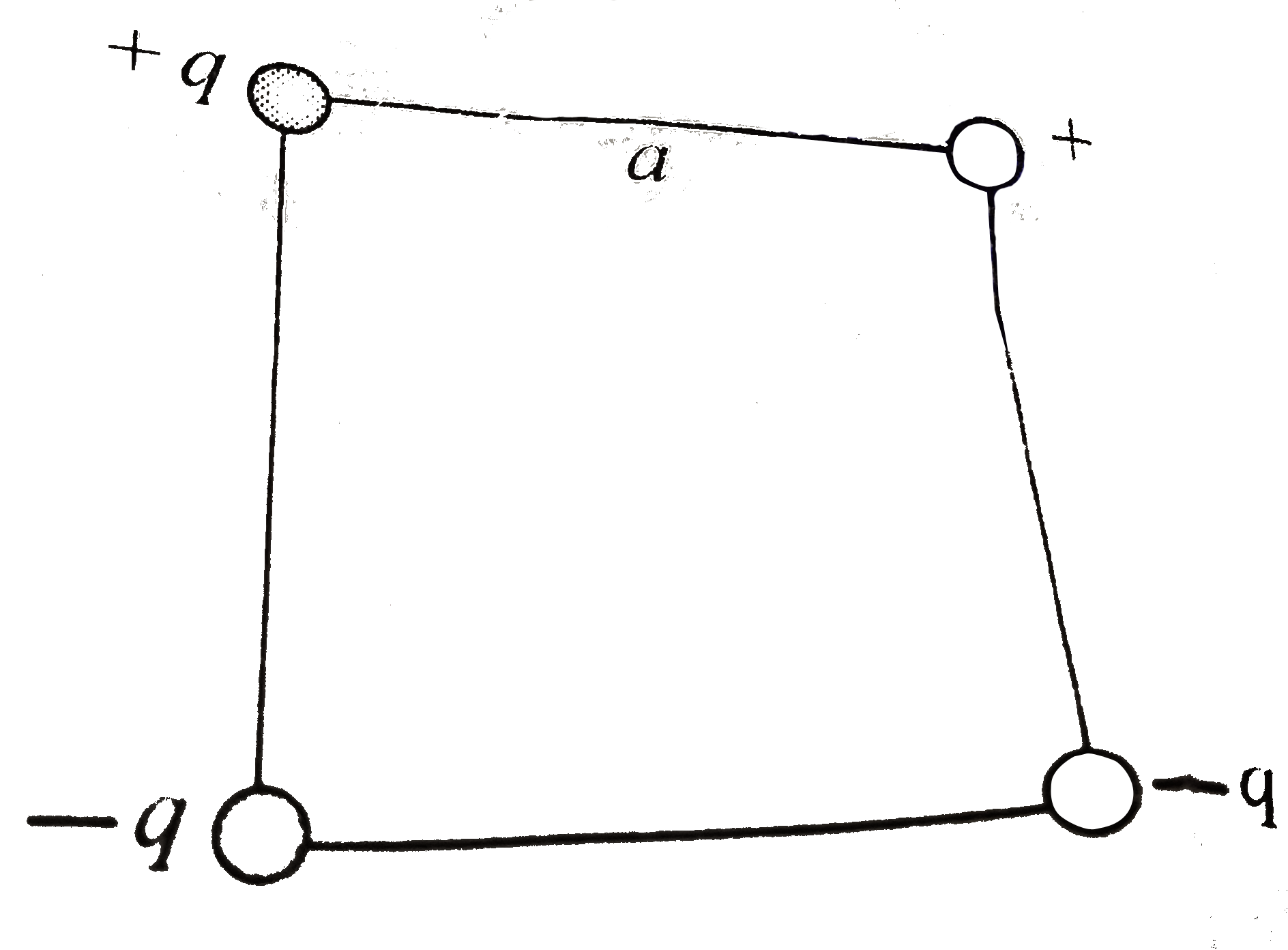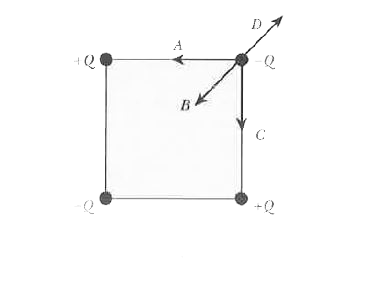Four point charges have the same magnitude of 2.4×10−12C and are fixed to the corners of a square that is 4.0 cm on a side. Three of the charges are positive and one is negative. Determine the magnitude of the net electric field that exists at the center of the square.
14N/C
27 N/C
42 N/C
54 N/C
The correct Answer is:D
To determine the magnitude of the net electric field at the center of the square formed by four point charges, we will follow these steps:
Step 1: Identify the Charges and Their Positions
We have four point charges:
- Three positive charges (+2.4 x 10^(-12) C)
- One negative charge (-2.4 x 10^(-12) C)
These charges are located at the corners of a square with a side length of 4.0 cm.
Step 2: Calculate the Distance from the Center to Each Charge
The distance from the center of the square to each corner (where the charges are located) can be calculated using the Pythagorean theorem. The distance r from the center to a corner is given by:
r=√(4.0cm)2+(4.0cm)22=√322=4√22=2√2cm=0.02√2m≈0.0283m
Step 3: Calculate the Electric Field Due to Each Charge
The electric field E due to a point charge is given by the formula:
E=k|q|r2
Where:
- k=8.99×109N m2/C2 (Coulomb's constant)
- |q|=2.4×10−12C
- r=0.0283m
Calculating the electric field due to one positive charge:
E+=(8.99×109)×(2.4×10−12)(0.0283)2
Calculating (0.0283)2:
(0.0283)2≈0.00080089m2
Now substituting back into the electric field equation:
E+=(8.99×109)×(2.4×10−12)0.00080089≈2.1576×10−20.00080089≈26.94N/C
Step 4: Calculate the Electric Field Due to the Negative Charge
The electric field due to the negative charge will have the same magnitude but will point towards the negative charge:
E−=(8.99×109)×(2.4×10−12)(0.0283)2≈26.94N/C
Step 5: Determine the Net Electric Field at the Center
Due to symmetry, the electric fields from the three positive charges will add up, while the electric field from the negative charge will point towards it.
The net electric field Enet can be calculated as follows:
1. The electric fields from the three positive charges will combine vectorially. Since they are symmetrically placed, their contributions in the direction towards the center will add up.
2. The negative charge will contribute an electric field pointing towards it.
Since the positive charges are symmetrically placed, the resultant electric field from the three positive charges will be:
Enet=3E+−E−
Substituting the values:
Enet=3(26.94)−26.94=53.88−26.94=26.94N/C
Final Result
The magnitude of the net electric field at the center of the square is approximately:
Enet≈54N/C
We have four point charges:
- Three positive charges (+2.4 x 10^(-12) C)
- One negative charge (-2.4 x 10^(-12) C)
The distance from the center of the square to each corner (where the charges are located) can be calculated using the Pythagorean theorem. The distance r from the center to a corner is given by:
The electric field E due to a point charge is given by the formula:
- k=8.99×109N m2/C2 (Coulomb's constant)
- |q|=2.4×10−12C
- r=0.0283m
The electric field due to the negative charge will have the same magnitude but will point towards the negative charge:
Due to symmetry, the electric fields from the three positive charges will add up, while the electric field from the negative charge will point towards it.
2. The negative charge will contribute an electric field pointing towards it.
The magnitude of the net electric field at the center of the square is approximately:
Topper's Solved these Questions
- BOOK - RESNICK AND HALLIDAYCHAPTER - ELECTRIC CHARGES AND FIELDSEXERCISE - Practice Questions (More than one correct Type )3videos
ELECTRIC CHARGES AND FIELDS
- BOOK - RESNICK AND HALLIDAYCHAPTER - ELECTRIC CHARGES AND FIELDSEXERCISE - Practice Questions (Linked Comprehension)5videos
ELECTRIC CHARGES AND FIELDS
- BOOK - RESNICK AND HALLIDAYCHAPTER - ELECTRIC CHARGES AND FIELDSEXERCISE - Problems63videos
ELECTRIC CHARGES AND FIELDS
- BOOK - RESNICK AND HALLIDAYCHAPTER - ELASTICITYEXERCISE - PRACTICE QUESTIONS (Integer Type)3videos
ELASTICITY
- BOOK - RESNICK AND HALLIDAYCHAPTER - ELECTRIC POTENTIALEXERCISE - (PRACTICE QUESTIONS) Integer Type1videos
ELECTRIC POTENTIAL
Similar Questions
Four charges are kept at the corners of a square of size a. Three charges are -Q and one is 3Q. Calculate the net electric dipole moment of this system.
 View Solution
View SolutionFour equal charges 2.0×10−6C each are fixed at the four corners of a squae of side 5 cm. Find the coulomba force eperienced by one of the charges due to the rest three.
View Solution
Knowledge Check
- Question 1 - Select One
Four point charge are placed at the corners of a square with diagonal 2a as shown. What is the total electric field at the center of the squre?
 Akq/a2 at an angle 45∘ above the +x-axisBkq/a2 at an angle 45∘ above the -x-axisC3kq/a2 at an angle 45∘ above the -x-axisD3kq/a2 at an angle 45∘ above the +x-axis
Akq/a2 at an angle 45∘ above the +x-axisBkq/a2 at an angle 45∘ above the -x-axisC3kq/a2 at an angle 45∘ above the -x-axisD3kq/a2 at an angle 45∘ above the +x-axis - Question 2 - Select One
Four charges are placed at four corners of a square as shown in figure. The side of the square is a. Two charges are positive and two are negative, but their magnitudes are the same. Now, an external agent starts decreasing all the sides of the square slowly and at the same rate. What happens to the electrical potential energy of the system and what will be the nature of work done by the agent?
 Aincreases, positiveBincreases, negativeCdecreases, negativeDdecreases, positive
Aincreases, positiveBincreases, negativeCdecreases, negativeDdecreases, positive - Question 3 - Select One
Four point charges, each of the same magnitude, with varying signs are arranged at the corners of square as shown in the figure below. Which of the arrows labelled A, B, C and D gives the correct direction of the net force that acts on the charge at the upper right corner ?
 AABBCCDD
AABBCCDD
Four charges of same magnitude and same sign are placed at the corners of a square, of each side0⋅1m. What is electric field intensity at the center of the square?
View SolutionThree equal charges, each having a magnitude of. 2.0×10−6C, are placed at the thre corners of a right. angled triangle of sides 3 cm, 4cm and 5 cm. find the three corner.
View SolutionThree equal charges, 2.0×10−6 C each, are held fixed at the three corners of a square of side 5 cm. find the Coulomb force experienced by one of the charges due to the rest two.
View SolutionThree Charges of magnitude 100μC are placed at the corners A, Band C ofan equilateral triangle of side 4m. If the charge at A and Care positive and the one at point B is negative, what is the magnitude and direction of total force acting on charge at C? [5.625N]
View Solution
A point charge q is placed at a distnace a/2 directly above the centre of a square of side a, as shown figure. Find the magnitude of the electric flux through the square.View Solution

